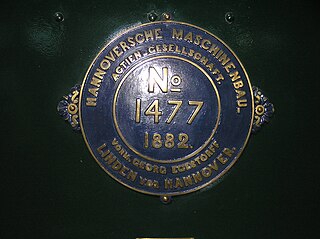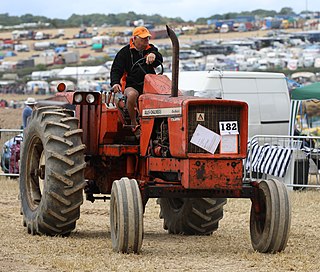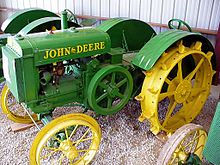
A tractor is an engineering vehicle specifically designed to deliver a high tractive effort at slow speeds, for the purposes of hauling a trailer or machinery such as that used in agriculture, mining or construction. Most commonly, the term is used to describe a farm vehicle that provides the power and traction to mechanize agricultural tasks, especially tillage, and now many more. Agricultural implements may be towed behind or mounted on the tractor, and the tractor may also provide a source of power if the implement is mechanised.

Deere & Company, doing business as John Deere, is an American corporation that manufactures agricultural machinery, heavy equipment, forestry machinery, diesel engines, drivetrains used in heavy equipment, and lawn care equipment. It also provides financial services and other related activities.

The International Harvester Company was an American manufacturer of agricultural and construction equipment, automobiles, commercial trucks, lawn and garden products, household equipment, and more. It was formed from the 1902 merger of McCormick Harvesting Machine Company and Deering Harvester Company and three smaller manufacturers: Milwaukee; Plano; and Warder, Bushnell, and Glessner. Its brands included McCormick, Deering, and later McCormick-Deering, as well as International. Along with the Farmall and Cub Cadet tractors, International was also known for the Scout and Travelall vehicle nameplates. In the 1980s all divisions were sold off except for International Trucks, which changed its parent company name to Navistar International.

Minneapolis-Moline was a large tractor and farm and industrial machinery producer based in Minneapolis and Hopkins, Minnesota, Minnesota known for its Minneapolis-Moline tractor line. It was the product of a merger of three companies in 1929: Minneapolis Steel & Machinery (MSM) which was noted for its Twin City tractors, Minneapolis Threshing Machine Company (MTM) which also produced Minneapolis tractors, and the Moline Implement Company formerly known as the Moline Plow Company. It had manufacturing facilities on Lake Street at Hiawatha Avenue in Minneapolis, MN, in Hopkins, MN and in Moline, IL. Originally known as the Minneapolis-Moline Power Implement Company, and later shortened Minneapolis-Moline Company. Motec Industries was a short lived corporate name change from ca. 1960 until the companies acquisition by White Motor Corporation in 1963.

Farmall was a model name and later a brand name for tractors manufactured by International Harvester (IH), an American truck, tractor, and construction equipment company. The Farmall name was usually presented as McCormick-Deering Farmall and later McCormick Farmall in the evolving brand architecture of IH.

Hanomag was a German producer of steam locomotives, tractors, trucks and military vehicles in Hanover. Hanomag first achieved international fame by delivering numerous steam locomotives to Finland, Romania and Bulgaria before World War I and making of first tractor Hanomag R26 in 1924 in Germany. In 1925, they added automobiles to their line, additionally moving in 1931 into the production of construction machinery. Since 1989, the company has been part of the Komatsu company.
Valtra is an agricultural machinery manufacturer based in Äänekoski, Finland. Valtra's products include tractors, combine harvesters, sugar cane harvesters, self-propelled sprayers and seed drills. Valtra has been part of the American AGCO Corporation since 2004.

The Allis-Chalmers One-Ninety XT, also known as the 190XT, is a row crop tractor produced by Allis Chalmers from 1964 to 1971. The tractors are powered by diesel fuel, gasoline, or LP gas. As its model number implies, it was based on the Allis-Chalmers D19 from the D Series, though it featured many alterations and improvements over the D19. The only difference between the 190 and the 190XT is the addition of a turbocharger on the 190XT diesels. Gasoline-run 190XT's also have a G2800 engine as opposed to the 190's G2500 engine. The stock 190XT is rated at about 93 PTO horsepower.

The Allis-Chalmers D series is a line of tractors made by the Allis-Chalmers Manufacturing Company from 1957 to 1969.

The International Harvester 1066 is a farm tractor that was made by International Harvester from 1971 to 1976. The 1066 has a six-cylinder diesel engine and about 105 drawbar and 125 PTO horsepower. The 1066 is significant for its popularity, with over 50,000 units having been built in its six-year run.

The John Deere 4020 was an agricultural tractor model made by John Deere from 1964 to 1972. It replaced the nearly identical 4010 that had been introduced with Deere's New Generation series in 1960 and offered a number of improvements over the previous model including more horsepower, heavier rear axles, and a differential lock. The 4020 was produced with three engine options: diesel, petrol, and LPG. The 4020 Diesel has a six-cylinder engine tested at 84 drawbar and 91 PTO horsepower. John Deere's Syncro Range transmission with 8 forward speeds and two reverse speeds was standard, a power shift transmission was optional. Other options included dual rear wheels and an enclosed cab with heat and air conditioning. The 4020 is significant for its great popularity; over 184,000 units were built. It was the most popular tractor of its time.

John Deere 3020 is a tractor that was manufactured by John Deere as part of its New Generation series from 1964 to 1972. The 3020 is nearly identical to the John Deere 3010 model that it replaced. It has a wheelbase of 90 inches, and a fuel capacity of 29 gallons. It was offered with three different engine options including a 3.7L 4-cyl gasoline engine, a 4.4L 4-cyl diesel and a 3.7L 4-cyl LP gas engine all produced by John Deere. The 3020 was rated at 71 horsepower. Transmission options included the standard Synchro Range transmission that offered 8 forward speeds and two reverse speeds and an optional eight speed power shift transmission. Several different tread options were offered by John Deere on the 3020 including, standard, narrow front Row Crop, narrow front Row Crop with "Roll-O-Matic", wide front Row Crop, Row Crop Utility. and Orchard.

Fiat Trattori S.p.A. was a Fiat group company founded in 1919, and was a constructor of agricultural equipment, tractors in particular. Over its decades of history, it established itself as Italy's leading constructor and one of the biggest in Europe; in 1991, it took over Ford-New Holland and adopted its name to increase its status on the world markets. In 1999, New Holland acquired Case Corporation to create CNH Global, in which Fiat Industrial was the majority shareholder until the two firms merged to create CNH Industrial in 2013.

The Ford NAA tractor is a tractor that was introduced by Ford as an entirely new model in 1953 and dubbed the Golden Jubilee.

The Farmall 06 series tractors are a family of row-crop tractors with six-cylinder engines, providing greater horsepower than the parallel product line of four-cylinder Farmall 04 series tractors. Until the late 1950s, Farmall and parent company International Harvester tractors used four-cylinder engines for general-purpose and row-crop tractors. Demands for higher performance and greater horsepower led to broader use of six-cylinder engines, with the bulk of International's production moving to the larger engines. The Farmall 806 and 706 were introduced in 1963, with production running to 1967. The Farmall 1206 was introduced in 1965 as the most powerful tractor of its time, using a turbocharged diesel engine. Production of the 1206 also ran until 1967. The 06 series sold well and was regarded as extremely successful.

The John Deere Model G tractor was a large three-plow row-crop tractor produced by John Deere from 1937 to 1953, with successor models produced until 1961. It was followed by the 70, 720, and 730.

The John Deere Model M tractor was a two-cylinder row-crop tractor produced by John Deere from 1947 to 1952, with successor models produced until 1960. It was succeeded by the updated 40, 420 and 430 models, as well as the 320 and 330 models that occupied the market positions left vacant by the more powerful 400 series models.

The John Deere Model R tractor was John Deere's first diesel tractor. A large, heavy tractor, it had fixed wheel widths and was not produced as a row-crop tractor with adjustable axles. The R was followed in the John Deere numbered model series by the John Deere 80, 820 and 830 tractors, which represented evolutionary upgrades to the basic R.

The Oliver 70 series of row-crop tractors was a series of large agricultural tractors produced from 1935 to 1967 by the Oliver Farm Equipment Company. Oliver tractors were known for their powerful engines compared to competitors, and their attention to styling. The Oliver Hart-Parr 70 marked the beginning of a strikingly-styled series of tractors that were produced under both the Oliver and the Cockshutt names. Oliver's emphasis on styling strongly influenced offerings by competing brands such as Farmall and John Deere.

The Oliver 60 series of row-crop tractors was a product line of agricultural tractors produced from 1940 to 1964 by the Oliver Farm Equipment Company. The 60 series was a four-cylinder follow-on to the six-cylinder Oliver 70. As the 70 was outsold by the less-expensive Farmall A, Allis-Chalmers Model B and John Deere Model B, Oliver introduced the 60 to compete.





























